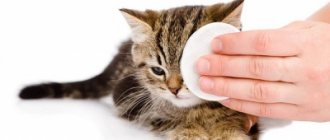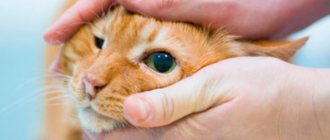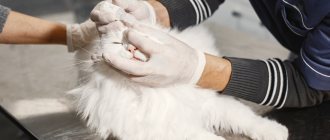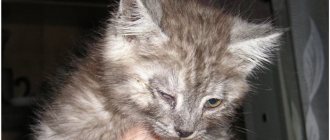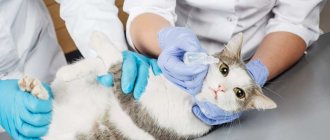Causes of tearing and souring
If your cat’s eyes are red and inflamed, there is constant tearing, accumulation of mucus, or, worse, inflammation, then this is a serious reason to immediately visit a veterinarian, who will examine the animal and determine the cause of such symptoms. The types of eye diseases in cats, like in humans, are very diverse.
Moreover, the eyes are a mirror not only of the animal’s soul, but also of the entire organism as a whole, so problems with the eyes can signal much more serious problems. Therefore, before rinsing your cat’s eyes, it would be good to determine the cause of the disease.
Inflammation can be caused by various diseases:
- conjunctivitis - inflammation of the mucous membrane, usually produces, in addition to lacrimation, purulent discharge;
- protrusion of the third eyelid - signals injury or the presence of viruses or worms in the animal’s body;
- keratitis - an inflammatory process in the cornea;
- cataract – clouding of the lens;
- glaucoma – increased intraocular pressure with clouding of the cornea;
- bulging eye - usually indicates injury or tumor;
- lacrimation - may be caused by the tear duct being blocked or producing too much tears.
Causes of discharge from a kitten's eyes
Often the kitten requires additional care for its eyes; tears and mucus appear. Usually the cause of lacrimation is a weak immune system, and until the kitten receives all the necessary vaccinations, the owners will regularly encounter similar problems. The main reasons requiring additional intervention and consultation with a veterinarian are:
- Conjunctivitis. With this disease, an increase in body temperature is possible. A brown crust appears in the corners of the eyelids, and the secreted mucus acquires a yellowish tint.
- Injury to the cornea of the eye. When injured, the eyeball becomes inflamed and turns red.
- The allergy causes itching, the animal constantly rubs its eyelids.
- Infection of the body with worms. If the reason lies in parasites, then the animal does not have a fever. There is no redness or swelling of the eyes.
It is necessary to begin treatment for inflamed eyes as soon as possible, as this can lead to a decrease in visual acuity.
Treatment methods
If your pet has eye pain, the first thing you need to do is take your pet to the vet. The doctor will be able to make the correct diagnosis and prescribe the necessary treatment, which will include the use of medications. Usually, for diseases of the visual organ, drops are prescribed that affect the cause of the disease.
In no case should you self-medicate without making a correct diagnosis; this can harm the animal and also cause serious complications, including loss of vision.
If the disease is not advanced, then it is usually possible to get by with rinsing and instillation; sometimes special eye gels or ointments are used. In especially severe cases, the cat is given injections.
Precautions
- Under no circumstances should alcohol solutions, antiseptics, or concentrates be injected into the eyes. This can cause a chemical burn to the surface of the eye.
- You cannot use plain water as a treatment - it disrupts the composition of the microflora of the eye and can dry out its surface.
- Do not use hot decoctions due to possible thermal burns.
- You should not use cotton wool or fibrous rags - the lint may get on the surface of the eye and may be difficult to remove.
- Do not use the same swab/cotton pad on both eyes. This way we can spread the infection from one eye to the other.
- Under no circumstances should treatment prescribed by a doctor be stopped without his knowledge and before the prescribed date.
What to wash with
In any case, in parallel with drug treatment, the doctor advises washing the animal’s eyes. Washing the eyes can be both one of the methods of treating the disease and a method of prevention.
If there is a disease of the visual apparatus with purulent discharge, it is recommended to rinse with furatsilin. It is best if the solution is prepared in a veterinary clinic, since the dilution dose should be very small - 1 mg per 5 liters of boiled water.
The cat's eye is a very sensitive organ, so even a slight excess of the dosage can cause irreparable harm to it. A two percent solution of boric acid can also be used for washing.
The question of how to wipe a kitten’s eyes, if it is healthy and the procedure is carried out as care or prevention, is decided by each owner independently. Decoctions of chamomile, sage, St. John's wort and calendula remove mucus well and have an anti-inflammatory effect. Even ordinary boiled water will do.
A healthy cat's eyes are always clear. The exception is the time immediately after sleep, when the beauty has not yet had time to put herself in order. There is no need to panic if a kitten, who was taken away from its mother early, does not yet know how to take care of itself and does not thoroughly clean its face; over time, it will learn everything and will delight its owner with the clear gaze of its naive eyes.
But if the cat constantly accumulates mucus in the corners, the eyes are red and inflamed, then this is already a cause for concern. This is a clear signal that the cat needs the help of a doctor.
In everyday life, in order not to miss the disease, it is worth examining the cat daily. If there are no strange manifestations and your pet’s eyes look healthy, then you need to clean them once a week. For this procedure, regular tea leaves or chamomile decoction are quite suitable. You need to soak a cotton swab in the liquid, and then gently wipe your eyes from the outer corner of the eyes to the inner. Kittens have their eyes washed every day until they learn to do it themselves.
How to clean your eyes
Cat's eyes are treated at home with both special preparations and improvised means.
Pharmacy products
Among the pharmaceutical products, the following are distinguished:
- Furacilin. You should purchase a solution with a concentration of 0.02%.
- Boric acid. It is used when there is no rupture of skin tissue and no bleeding.
- Saline solution 0.9%.
- Chlorhexidine.
- Potassium permanganate. The rinsing solution should be pale pink in color.
- Drops designed specifically for cats. They do not harm the kitten's body.
- Drops containing antibiotics. They are used to clean the eyes when treating conjunctivitis.
Home Remedies
You can wash your cat's eyes at home using:
- Black, weakly brewed tea. The tea should be used 10 hours after brewing.
- Herbal decoction (chamomile, St. John's wort or calendula). Brew 2 tablespoons of herb in 0.5 cups of water. After 10 minutes, you can begin the eye wash procedure.
The simplest treatment option is to wash the damaged area with warm boiled water.
How to properly wash your eyes
As a rule, cats do not like any procedures with their eyes; they can push the owner away with their paws, meow pitifully, and sometimes even defend themselves with all their claws and teeth. Therefore, the owner of the obstinate creature needs to carefully prepare for the procedure and study the question of how to wash the eyes of his pet without damaging it, and, accordingly, without allowing the cat to scratch itself.
First of all, you need to prepare everything for washing your pet’s eyes; wash your hands with soap before the procedure. It is best to swaddle your pet with a towel, otherwise the baby will struggle and scratch, certainly trying to escape. It is best to carry out eye procedures together, so that one person holds the animal, and the second performs the necessary manipulations.
Cotton swabs need to be well soaked in the prepared solution or decoction to gently soften and remove crusts before the eyes without causing pain to your four-legged friend. After the crusts have softened, the tampon is changed and the eyes are thoroughly washed so that the herbal decoction or medicinal solution gets into the eyes. You can drop the product into your eyes using a pipette.
At the end, the animal’s eyes should be wiped with a dry cloth. After all the manipulations performed, the animal must be released and treated to something tasty so that the pet relaxes and does not take offense at the owner.
However, if you teach your pet to wash its eyes from a young age, then this will not cause any difficulties later. The animal realizes that the person is helping him, so he allows him to quickly carry out all the procedures, in the hope of then getting his portion of goodies.
Features of discharge that help assess the situation
The nature of the discharge helps to make a correct diagnosis:
- Thick discharge, with the presence of pus, which sticks together the pet’s eyelids, is yellow in color and is characteristic of fungal, bacterial and infectious diseases.
- Watery and clear discharge occurs when an allergic reaction develops or the eyes are injured.
- Transparent tears that, when dry, form brown discharge in the corners of the eyes, indicate that the kitten has gotten dirty.
Symptoms of suppuration
Suppuration is visible to the naked eye. Usually the pus dries out and forms a light gray crust. Dried drops form on the fur in the area of the eyes and nose. Too much discharge can even “glue” the eye and it will not open. Kittens will try to remove the formations by washing, but this can only worsen the situation: the infection will spread, and the results will not be the most pleasant.
The pus may be white, yellow, green, or brown. It is important to pay attention if your pet frequently blinks or squints, rubs its eyes with its paws, or sneezes. Older kittens may hide in secluded places. If the baby was active and playful, but suddenly became apathetic, then this is a clear reason to examine him and see a doctor.
Symptoms can tell what disease the kitten’s body has been exposed to. Here are the most common:
- Sour eyes, snot, inflamed and red eyelids. Reason – conjunctivitis. It is divided into four groups according to the nature of the disease.
- Infection occurs against the background of irritation of the mucous membrane (dust, chapping, other external irritants).
- Viral is a symptom of a contagious disease that develops covertly or acutely.
- Chronic occurs when the eyes are dry, the nasolacrimal ducts do not work properly, and ulcers form on the corneas.
- Allergies develop against the background of constant stimulation of the immune system by allergens.
- Purulent eyes, severe runny nose, wet cough, sneezing, upset stomach. The cause is toxoplasmosis , a parasitic disease. Usually occurs in outdoor kittens.
- Swelling, severe pain, the kitten reacts sharply to any touch in the eye area. The reason is blockage of the tear ducts . Usually occurs in babies up to three weeks of age. Pain and discomfort are caused by the accumulation of pathological exudate in the lacrimal canal.
- Swollen eyes, sneezing, coughing, purulent discharge. The cause is chlamydia . The infection affects not only the mucous membranes of the eyes, but also the respiratory tract, digestion and genitals.
- Purulent eyes, cough, rhinitis. The cause is mycoplasmosis . The infection first affects the organs of vision, and then the respiratory system. If treatment is not started in time, the kitten will develop diseases of the genitourinary system, liver and joints.
- Your eyes hurt, tears flow, your eyelids swell. The owner observes that the animal has inflamed eyes, eyelids stuck together from pus and ichor, bleeding and bruising are possible. The reason is injuries . It is important to start treatment in a timely manner, otherwise bacteria will penetrate through small wounds.
Important! Examine a kitten's eyes only with clean hands. It is recommended to wash your hands with laundry soap or disinfect with hydrogen peroxide. This way you can prevent the introduction of even more dangerous viruses.
Additional Tips
Once you've adopted a kitten or cat, get them used to the process so they don't find it weird when you do it regularly. If your cat has long hair, try trimming it around the eyes. Little do you know, their corneas can be scratched by their own hair!
Besides, your cat is the most unpredictable, impulsive creature. It's always best to keep an eye on them. If you'll be gone for long hours, make sure there's at least someone to keep an eye on them. Always have someone help you when cleaning your cat's eyes, as they move around a lot and won't want to cooperate with you in this process.
If the crusty, mud-like appearance continues to appear no matter how many times you clean it a day, they will need professional medical attention. Also, if you see that your cat has trouble opening its eyes or there is swelling after you have cleaned the eyes, immediately take him to the nearest veterinarian for further examination.
Disease prevention
Need to know! You can protect yourself from bacterial conjunctivitis by following standard preventive measures.
Particular attention should be paid to personal hygiene : you should try to avoid direct contact of any objects that could potentially become a source of infection with the surface of the eyes.
Also, do not constantly rub your eyes with dirty hands , and when working in unfavorable environmental conditions (in
contaminated workshops or in smoky rooms),
protective glasses must be used.
If contact lenses are used, they can only be stored under the conditions prescribed by the manufacturer : in special containers that are filled daily with fresh disinfectant solution.
What is bacterial conjunctivitis?
Reference! The outer part of the eye is covered with conjunctival epithelial tissue, which protects the organs of vision from the effects of negative external factors and prevents the eye from drying out.
When pathogenic microflora in the form of bacteria gets , inflammatory pathological processes begin to develop.
Moreover, this form of conjunctivitis is characterized by its rapid progression.
The disease can occur in one of three forms:
- Spicy. Signs and symptoms in the acute form develop quickly, but not as quickly as in the fulminant form. Characterized by abundant discharge of purulent exudate from the affected organs of vision . If left untreated, the disease can become chronic, but with adequate therapy, the acute type of bacterial conjunctivitis can be successfully treated within two weeks.
- Chronic. It is the result of the development of an acute form of the disease, and the greatest likelihood of transition to this stage occurs when the organs of vision are damaged by Staphylococcus aureus. Often, in the chronic form, blepharitis additionally develops.
- Lightning fast. The symptoms of this type of bacterial conjunctivitis are especially pronounced, and the development of the disease occurs in a maximum of three days. The most serious complication with this form is the development of pathological processes in the cornea of the eyes.
What and how to treat?
The first step when diagnosing bacterial conjunctivitis is to isolate an adult patient .
himself
must more carefully observe the rules of personal hygiene : do not touch his eyes with his hands, wash his face several times a day, use only his own clean towel.
During treatment, the patient must undergo a biomicroscopic examination ; it is also possible to take a sample from the conjunctiva of the eye (this is done through a smear).
Such diagnostic measures make it possible to identify the causative agent of the disease as accurately as possible.
After which treatment will be prescribed using one of these ointments:
- tetracycline;
- erythromycin;
- gentamicin.
Additionally, depending on the situation, the ophthalmologist will prescribe antibiotic and anti-inflammatory eye drops .
How long is the treatment? As a rule, the disease is treated within 5-7 days, less often recovery occurs after 2-3 weeks. The timing depends on the type of bacteria, the therapy performed and the general condition of the body. Bacterial conjunctivitis is treated with tetracycline-based antibiotics.
